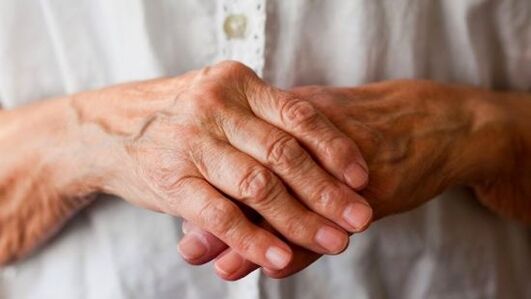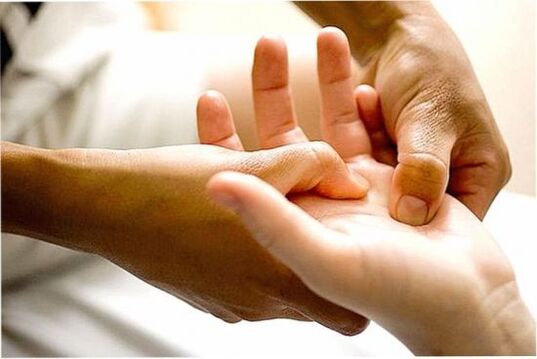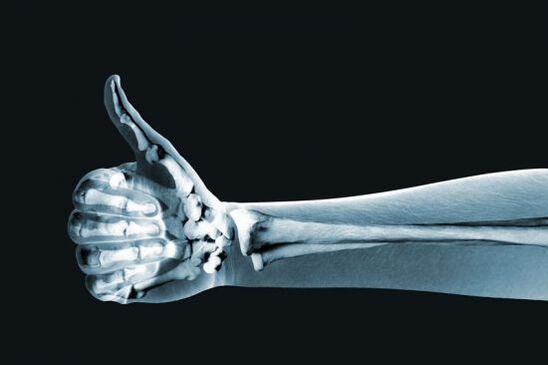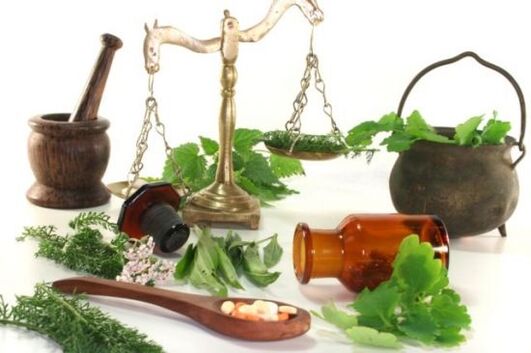When your hands and fingers hurt, it means the body is signaling about joint disease or internal pathology. Often patients try to solve the problem themselves, not realizing the danger of becoming disabled in a short time. Information about why pain occurs in the finger joints and what to do is useful for those who have felt the first symptoms of the disease and who have close relatives suffering from articular pathology.
Cause
There are several diseases that are accompanied by pain and inflammation of the hands. This includes:
Gouty arthritis
This disease shows itself more than 20 years. The thumb is the first to experience the inflammatory process. There is a paroxysmal course of joint inflammation. Attacks most often begin at night. Joint pain is acute. The area of skin over the affected joint becomes purple. Fingers become hot and difficult to bend. Inflammation lasts a maximum of 10 days. Attacks may disappear suddenly, without treatment, but soon reappear.
Polyosteoarthrosis
People over the age of 40 are affected: men - less often than women. A typical sign of this disease is Heberden's nodule, when the nodule begins to form, swelling and redness in the joints, burning, and sharp pain are observed; in some patients, nodules form without symptoms. With polyosteoarthrosis, the formation of nodules in the joint in the middle of the finger is also observed. Bouchard's nodules are spindle-shaped, almost painless, and characterized by slow growth.
Rheumatoid arthritis
The onset of the disease is indicated by inflammation of the joints of the index and middle fingers. Along with the metacarpophalangeal joint, the wrist joint becomes inflamed, swollen, and painful. Pain in the joints of the fingers is very painful in the morning. Rheumatoid arthritis is accompanied by weakness, joint pain, and fever.

Psoriatic arthritis
Pathology develops in patients with psoriasis. In pathology, joint pain and swelling are noted. The pathology has another name - "sausage-shaped" fingers. At the same time, all joints and finger joints become inflamed. In rare cases, the joints on both hands become inflamed, but on different fingers.
De Quervain's tenosynovitis
Inflammation affects only the thumb. Pain caused by weight when trying to straighten the elbow towards the elbow. Sometimes your fingers hurt for no apparent reason.
Rhizarthrosis
A rare pathology. Rhizarthrosis is a form of chronic arthrosis. Localization is noted at the base of the thumb. This disease leads to deformation of cartilage tissue. The bones of the thumb become deformed, limiting the movement of the inflamed joint.
Carpal tunnel syndrome
Pathology is indicated by symptoms:
- Pain is felt on the inside of the thumb.
- My index finger hurts.
- There is numbness in the skin of the palm.
- Decreased hand motility.
Without treatment, the nerves lose their ability to function, leading to disability.
Raynaud's disease
The cause of this disease is a decrease in capillary tone. Manifested by symptoms: numbness, pale skin of the hands, vasodilatation, resulting in redness of the fingers. Sometimes there is bluish color, acute pain, and swelling. The pathology is characterized by continuous freezing of the hand, which in the final stages of development becomes bluish or black. Trophic ulcers are often observed.
injury
Pain in the hand most often occurs with bruises and sprains. Hand bruises are indicated by the following symptoms: swelling, bluishness or redness of the bruised site, severe pain when trying to move the finger, hematoma formation, and pathological mobility of the injured finger.

Tendinitis
This disease affects a person who constantly performs monotonous movements (sewing, typing, playing the piano). "Writing" cramps occur during the daily stress of typing. A painful syndrome is observed in people suffering from cervical osteochondrosis. Wrist pain is especially noticeable at night. The painful sensation is often accompanied by a sound similar to a crackling sound.
Tingling and numbness in the fingers appear in a person who makes small movements with his hands. Repetitive hand pressure contributes to trigger finger syndrome. Crooked fingers are difficult to straighten; if force is applied to straighten it, a clicking sound is heard.
Pain due to internal pathology
Often there is pain in the hands and fingers for reasons unrelated to joint disease. People suffering from pathology are at risk:
Cardiac ischemia . With myocardial infarction, the onset of the attack often coincides with pain and tingling in the left hand.diabetes . Pathology leads to a more sensitive hand condition due to poor circulation.
Pain and numbness are often observed in pregnant women. The following changes lead to swelling and pain in the finger joints during pregnancy: increased amount of relaxin hormone, lack of calcium, pinched median nerve, depression.
Important!Heredity, freezing of the hands, frequent immersion in cold water, decreased immunity contribute to pathological changes in the hands.
Pain in the fingers of the right hand
Several fingers hurt at the same time. Half of the painful manifestations occur on the ring and little fingers, and a third on the index and thumb. If the pain is felt in all the fingers of the right hand, the problem is related to the blood vessels. Pain in the index finger and thumb indicates spinal pathology. If the index, ring and thumb hurts at the same time, this indicates radial nerve disease. Simultaneous pain in the little finger and ring finger indicates the presence of a foraminal hernia.
The fingers on my left hand hurt
If the pain occurs in all the fingers of the left hand only, the problem is sought in the blood vessels. Painful thumb, index and ring fingers - affected radial or central nerve, index and thumb - spinal pathology. Pain in the little finger and ring finger occurs with C5-C6 foraminal hernia. Middle finger joint pain due to C4-C5 foraminal hernia.
Which specialist to choose
For whatever reason your hand hurts, a visit to the doctor is mandatory. If you have pain after trauma, you should make an appointment with a traumatologist. If the joint becomes inflamed or swollen, a rheumatologist will help. When the cause of the pain is not clear, you should consult a cardiologist and an endocrinologist.
Diagnostics
It is possible to diagnose pathology using the following hardware tests:
Radiography . A painless procedure makes it possible to study bone tissue. The results of the study were recorded on film in 3 projections.CT . The study was carried out using x-rays. The result obtained after computer processing is a series of cross-sectional images.Electrospondylography . Detects the presence of abnormalities in the part of the spine responsible for arm function. Pathology is detected at an early stage of development.MRI . Diagnosis is carried out using electromagnetic radiation. As a result of the study, longitudinal and transverse sectional images were obtained.

Laboratory methods
To diagnose joint pathology, studies are carried out:
General urine analysis . Allows to identify advanced forms of bone inflammation.General blood analysis . The study determined the presence of leukocytosis and anemia.Biochemical blood test . Determines the increased presence of fibrinogen and sialic acid.Puncture . After puncturing the affected joint, the fluid inside is taken for examination. This study is designed to accurately determine the cause of the development of pathology; carried out in rare cases.Biopsy . A piece of skin tissue is taken for microscopic examination. Using that method, lupus erythematosus and scleroderma are detected.
Treatment
Pain in the hand is treated according to the cause. For exacerbation of arthritis, non-steroidal anti-inflammatory drugs are used. For the normal supply of nutrients from the blood to the joints, the use of vasodilator drugs is necessary. Anti-inflammatory ointment is used for local therapy. Good results are obtained when treating arthritis with ultrasound, electrophoresis, and acupuncture.
For osteoarthritis, centrally acting analgesics are prescribed to relieve patients of acute pain. In addition to relieving pain, the drugs have an anti-inflammatory effect. Chondroprotectors: chondroitin sulfate, hyaluronic acid in some cases taken continuously. Laser treatment has been successfully used in the treatment of osteoarthritis. Significant relief is obtained using physiotherapeutic procedures: massage, mud therapy.
For gout, drug intake is shown to normalize purine metabolism in the body. Analgesics are prescribed to relieve pain. Especially important is a diet with limited consumption of meat products, fish, and alcohol. Rheumatoid arthritis cannot be cured, but it is possible to slow down the process of joint destruction by using anti-inflammatory drugs, physiotherapy, and surgical methods. Acupuncture and massage have also proven themselves well.
To treat carpal tunnel syndrome, comfortable working conditions should be created, taking into account the correct position of the hands. For painful sensations, make a compress from chamomile decoction.
Surgical method
If conservative treatment is ineffective, the joint is replaced surgically. Indications for surgical intervention are:
- Injury with the separation of the tendon from the place of attachment to the phalanx of the nail.
- Arthritis in the hands.
- Broken and cracked.
- Deep cut.
- Malignant neoplasm of the hand.

How to treat according to traditional recipes
Effective folk recipes to combat pain in the hands:
Recipe No. 1 . Aloe ointment. Take 20 g of crushed fresh aloe leaves, add 5 g of dry mustard. Mix and simmer for 8-10 minutes until a homogeneous mass is obtained. Transfer to a container away from light. The joints of the hands are lubricated in the morning and evening until an improvement is seen.Recipe No. 2 . Bird cherry colored. 50 g of bird cherry skin is poured with 200 ml of vodka. Insist for 10 days without access to light. Lubricate the brush 3 times a day. The course of treatment is 3 weeks.Recipe No. 3 . Bath with calendula. A spoonful of dried calendula flowers is poured into 200 ml of boiling water. Prepare the stew for 15 minutes. on low heat. The treatment procedure continues for 20 minutes. The course of treatment is 10 procedures.Recipe No. 4 . Drink from dandelion root. So, 1 tablespoon of dandelion root is poured into 200 ml of boiling water. Simmer for 20 minutes. Drink 1 tablespoon 15 minutes before meals for 14 days.Recipe No. 5 . Three tablespoons of sea salt heated in the microwave. Wrap it in a gauze bandage, apply it to the joint, and leave it for 30 minutes.
This procedure is done every day for 20 days.
Useful tips
By following the doctor's recommendations, you can help the body reduce joint disease. If hand swelling occurs, jewelry should be removed. In case of injury, the hands should be still and use a cold compress. If there is pain due to energy, it should be eliminated or significantly reduced. Need to change work that requires repetitive movement.
You should see a doctor immediately if the following symptoms occur:
- Post-traumatic pain does not subside, stiffness of movement is observed, and it is difficult to bend the fingers.
- Hands are red and there is heat in the skin area.
- There is a tingling sensation in the hand.
- The phalanges of the fingers hurt.
- Hands or fingers become numb.

Prevention
To avoid pain in the hand, you should:
- Include exercises to strengthen your hand muscles in your morning workout routine.
- If repetitive movements are required, you need to rest.
- Staying for a long time in a position that requires a fixed position of the hands should be avoided.
- Avoid cooling your hands too much.
Pain in the hand is caused by various reasons. To relieve pain, drug treatment, physiotherapy, surgical methods, and folk recipes are used. To improve your quality of life, it is important to follow your doctor's recommendations.

























